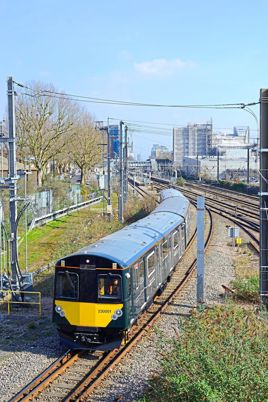Government should order battery electric trains to replace the 1,100 oldest diesel units in service.
That’s the call from the Railway Industry Association, which also wants to see the electric network increased from today’s 38% of all lines to 66%. It argues that this would allow all passenger and 95% of freight services to be decarbonised by 2050.
Launching a new report on April 11, RIA Technical Director David Clarke said this would have flattened the boom-and-bust profile seen in rolling stock orders and electrification schemes.
Siemens Head of Business Development Graeme Clark said it could take four and a half years from signing a contract to bringing a battery electric train into operation, with follow-on orders faster at two and a half years.
Clark noted that Siemens had, a few days earlier, introduced a first fleet of Mireo Plus B battery electric trains to service in Germany. He suggested that the batteries in such trains would last 20 years, and that even then, they could be reused in less demanding roles than rail.
Angel Trains Asset Management Director Matthew Prosser argued that private investment would be the only way to deliver decarbonisation quickly, because government had higher priorities than transport for public funds.
Prosser said that Angel Trains viewed battery trains as an opportunity because their technology was mature, and their risks could be controlled.
However, he went on to say that RIA’s plan needed a “whole system approach” that was fundamentally different to what had been done before.
Rail Partners Operator Services Director Mark Gaynor responded to RIA’s report, saying: “We support the Railway Industry Association’s ambitions for decarbonising the railway for both passenger and freight operations in a realistic and cost-effective way.
“We agree that the industry needs to come together to prepare and start delivering a strategy to enable a lower-cost, higher-performing, net zero railway for passenger and freight by 2050.”
RIA’s plan put forward a model based on total costs (that is the combination of capital and operating costs).
Using work from consultant Arthur D Little, which looked at the line from Bristol to Penzance, RIA claims that partial electrification and battery trains become cheaper from the 14-year point, compared with carrying on with diesels and replacing them with diesel hybrids when required.
By contrast, it would take nearly 29 years for full electrification and electric multiple units (EMUs) to become cheaper than continuing with today’s diesel fleet.
This model uses public finance and, according to RIA, the battery option saves £786 million over 30 years. Private finance gives a saving of £595m over the same period, with the saving between continuing as now and switching to battery units becoming apparent from around ten years.
Clarke said that this ‘total cost’ approach should be used across unwired routes in combination with route profit and loss figures from the Great British Railways Transition Team, to give a more rounded picture of costs and benefits.
For now, RIA proposes wiring schemes in outline that extend the range of battery trains. This includes Shrewsbury-Hereford, London Marylebone-Princes Risborough, Westbury-Newton Abbot, Plymouth-Par, Carmarthen-Whitland, Leeds-Todmorden via Bradford Interchange, and Newcastle-Hexham.
In addition, RIA suggests installing fast-chargers for battery electric multiple units on lines without overhead line equipment.
In Wales, it suggests around Newtown and Harlech on the Cambrian Coast, and Builth Road and Llandovery on the Heart of Wales route.
In northern England, it suggests chargers around Kirkby Stephen on the Settle-Carlisle route, as well as Whitehaven and Barrow-in-Furness on the Cambrian Coast.
Scottish charges might be placed at Crianlarich, Fort William, Helmsdale and Thurso.
Clarke told a briefing in London on April 11 that battery trains were now running on the network and showing their potential, whereas four years ago they could only show promise.
Since then, Merseyrail has introduced a battery version of its Class 777 EMU (albeit with some problems), while Great Western Railway has a fast-charge battery Class 230 under intensive tests.
In addition, Prosser said that Angel Trains was equipping a Class 802 from the TransPennine Express fleet with batteries, to create a tri-mode train (diesel, electric and batteries).
RIA’s plan builds on current schemes (such as Midland Main Line and Transpennine Route Upgrade in England, and Transport Scotland’s plans) that lift the electrified proportion of the network to 48%. Adding the Department for Transport’s Network North proposals, which include the Hope Valley Line, extending to Hull, and (RIA assumes) East West Rail, brings the proportion to 51%.
Incorporating proposals by the Chartered Institute of Logistics and Transport (CILT) for wiring strategic freight routes (which include Peterborough-Doncaster via Lincoln, Bristol-Birmingham, and the route from Reading to the Mendip Quarries via Westbury) and infill schemes takes the proportion to 59%.
Add the RIA proposals to this, and Britain would have 66% of its network electrified. Clarke said he reckoned that getting there would need no extra government funding in the next decade.
Clarke called RIA’s proposal a “plan of thirds”, with one-third of the network already electrified, one-third needing to be electrified for decarbonisation, and one-third that could be run with battery electric passenger trains.

















Login to comment
Comments
No comments have been made yet.